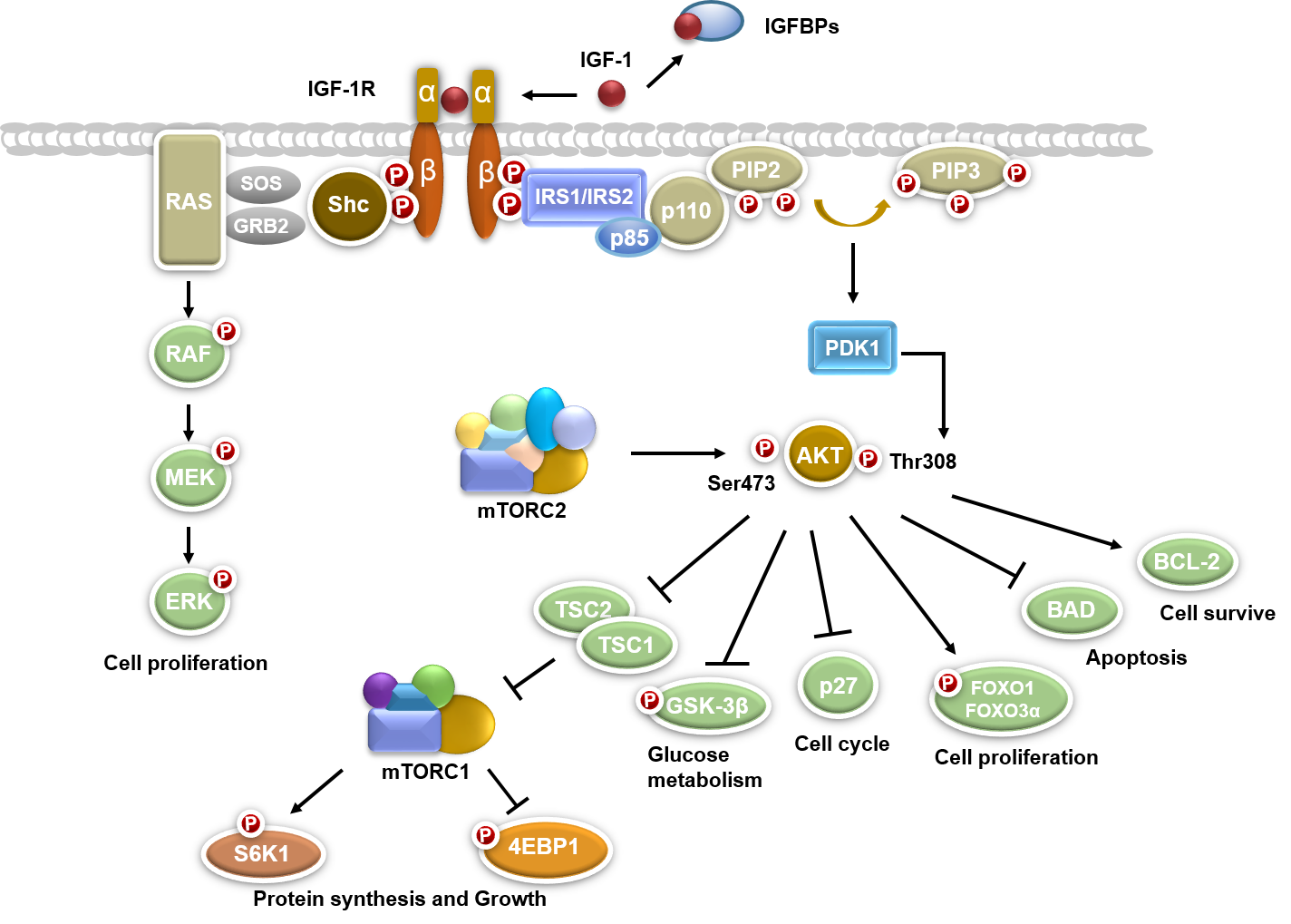
Our promise to you:
Guaranteed product quality, expert customer support.
 24x7 CUSTOMER SERVICE
24x7 CUSTOMER SERVICE
 CONTACT US TO ORDER
CONTACT US TO ORDER
IGF-1 Gene Editing 
IGF1 (Insulin-like growth factor 1), also known as growth regulator C, is a small peptide consisting of 70 amino acids. Similar to insulin, IGF-1 has A and B chains linked by disulfide bonds, and the C peptide region has 12 amino acids. Approximately 98% of IGF-1 binds to IGF-BP, of which IGFBP-3 is the most abundant protein, binding 80% of IGF1. IGF-1 is mainly produced by the liver as an endocrine hormone and in a paracrine/autocrine manner in target tissues, stimulated by growth hormone (GH) and can be delayed by failure of undernutrition, growth hormone insensitivity, lack of growth hormone receptors or GH receptors.
IGF-1 stimulates the growth of the whole body and acts on almost every growth-promoting effector cell in the body, especially skeletal muscle, cartilage, bone, liver, kidney, nerve, skin, hematopoiesis, and lung cells. Except for the similar effects of insulin (Figure 1), IGF-1 also regulates cellular DNA synthesis, besides activating IGF-II gene expression. Due to the important effects of IGF1 on growth and development, it is clear that the imbalance of the IGF system can affect many different conditions, including normal growth, central nervous system diseases (e.g. Alzheimer's disease), diabetes, and even cancer.
 Figure 1: The insulin growth factor 1 (IGF-1) signaling pathway (Hwa Jin Jung. 2014)
Figure 1: The insulin growth factor 1 (IGF-1) signaling pathway (Hwa Jin Jung. 2014)
In addition, IGF-1 is an important signaling molecule for cancer cell transformation and proliferation, and IGF-1/IGF-1R binding and activation are key steps for downstream events, including mitosis and inhibition of apoptosis. When IGF-1 binds to IGF-1R, tyrosine kinase activates the PI3K-AKT pathway regulating cellular metabolism, apoptosis, cell adhesion and angiogenesis. Studies have shown that inhibition of IGF-1R activation by small molecule inhibitors or biologics may be an important step in identifying viable cancer therapies. And now, the IGF protein family remains a viable target for new therapeutic agents.
IGF1 Gene Editing Service
CRISPR/Cas9 PlatformCB, a global leading biotechnological company specializing in gene editing, is dedicated to offering comprehensive CRISPR/Cas9 gene editing services and products for academic research, biotech research and pharmaceutical drug discovery. Based on our platform, we are able to help you effectively control target genes knockout/knockin/point mutation in cells or animals via CRISPR/Cas9 technology.
- IGF1 Gene Editing Cell Line Generation
Our professional scientists have successfully implemented IGF1 CRISPR/Cas9 gene edited in both easy-to-transfect cell lines and hard-to-transfect cells. With deep gene editing knowledge and extensive experience in experimental operation and data processing, we provide you with full-length custom IGF1 gene editing service from strategy design to final stable cells. Our IGF1 gene editing cell line generation services include:
➢ gRNA design and synthesis
➢ Transfect the cell lines you're interested
➢ Select the high expression cells and sort monoclonal cell
➢ Validate the knockout/knockin/point mutation of IGF1 by PCR and sequencing
➢ Produce cryogenic preserved vials of stable cells and a final report
Typically, we develop CRISPR-mediated gene editing cell lines including HEK239T, Hela, HepG2, U87, but we can use other cell lines according to your requirements.
Other host cell lines available: Ba/F3, CHO, MDA-MB-453, MDA-MB-231NIH3T3, T47D, Neuro2a, MCF7, RKO, K562, RAW264.7, etc.
- IGF1 Gene Editing Animal Model Generation
CRISPR/Cas9 PlatformCB also has extensive experience in incorporating CRISPR/Cas9 technology into animal models, which have been fully recognized by our clients. Tell us your projects’ needs, we provide a one-stop-shop IGF1 CRISPR/Cas9 gene editing animal service and guarantee at least 2 founders or 3 F1 animals with shorter turnaround time and lower price. Our IGF1 gene editing animal model generation services include:
➢ IGF1 gene conventional knockout animals
➢ IGF1 gene conditional knockout animals
➢ IGF1 point mutation animals
➢ IGF1 knockin animals
Alternative species: mouse, rat, rabbit, zebrafish, C. elegans, etc.
CRISPR/Cas9 PlatformCB is devoted to providing the best gene editing services to accelerate the achievement of your research goals. With skilled and experienced genomics experts, we are committed to providing the most reliable and effective research services and products to best meet your research goals with excellent quality management and quality assurance capacity. If you have any questions, please feel free to contact us.
References
- Z Laron. Insulin-like growth factor 1 (IGF-1): a growth hormone. Mol Pathol. 2001; 54(5):311-316.
- Vladimir N. Anisimov and Andrzej Bartke. The key role of growth hormone — insulin — IGF-1 signaling in aging and cancer. Crit Rev Oncol Hematol. 2013; 87(3):201–223.
- Vittorio Emanuele Bianchi. Neurotrophic and Neuroregenerative Effects of GH/IGF1. Int J Mol Sci. 2017; 18(11):2441.
- Baserga R. et al. The IGF-1 Receptor in Cancer Biology. Int. J. Cancer. 2003; 107:873-7.
- Rosenbloom AL. The role of recombinant insulin-like growth factor I in the treatment of the short child. Curr Opin Pediatr. 2007; 19(4):458-64.
- Kalebic T. et al. In Vivo Treatment with Antibody against IGF-1 Receptor Suppresses Growth of Human Rhabdomyosarcoma and Down-Regulates p34cdc2. Cancer Res. 1994; 54:5531-4.
- Keating GM. Mecasermin. BioDrugs. 2003; 22(3):177-88.
- Yakar S. et al. Circulating levels of IGF-1 directly regulate bone growth and density. Journal of Clinical Investigation. 2002; 110(6):771-781.
- Hwa Jin Jung and Yousin Suh. Regulation of IGF -1 signaling by microRNAs. Front Genet. 2014; 5:472.